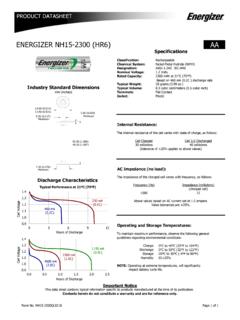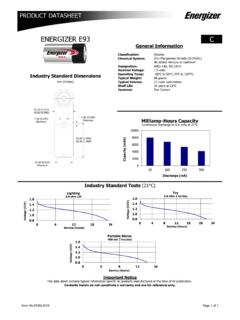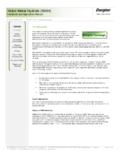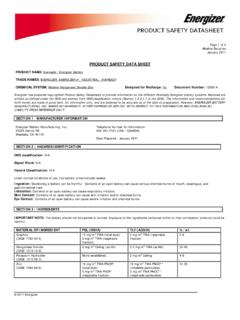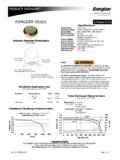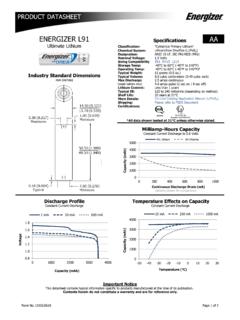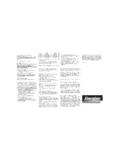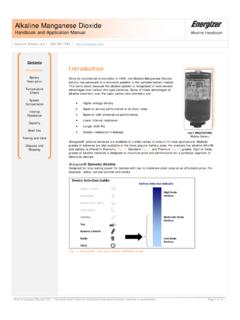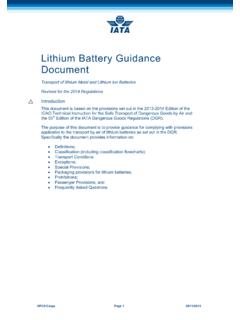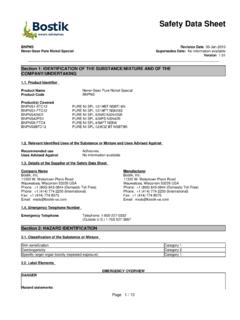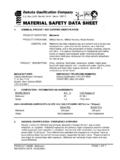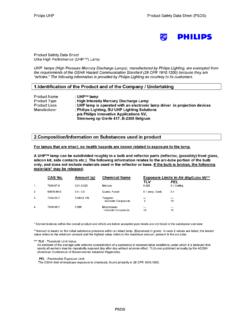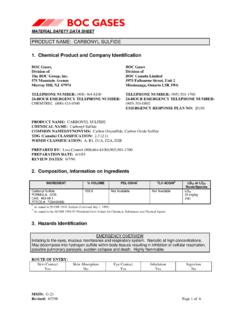Transcription of PRODUCT SAFETY DATA SHEET
1 Page 1 of 5 nickel Metal Hydride Batteries January 2017 2017 Energizer PRODUCT SAFETY data SHEET PRODUCT name : Energizer Rechargeable Battery Type No.: Volts: TRADE NAMES: ENERGIZER nickel Metal Hydride Battery Approximate Weight: CHEMICAL SYSTEM: nickel Metal Hydride Designed for Recharge: Yes Document Number: 12006-B Energizer has prepared copyrighted PRODUCT SAFETY Datasheets to provide information on the different Eveready/Energizer battery systems. Batteries are articles as defined under the GHS and exempt from GHS classification criteria (Section of the GHS). The information and recommendations set forth herein are made in good faith, for information only, and are believed to be accurate as of the date of preparation. However, ENERGIZER BATTERY MANUFACTURING, INC. MAKES NO WARRANTY, EITHER EXPRESS OR IMPLIED, WITH RESPECT TO THIS INFORMATION AND DISCLAIMS ALL LIABILITY FROM REFERENCE ON IT.
2 SECTION 1 - MANUFACTURER INFORMATION Manufactured for: Energizer Battery Manufacturing, Inc. Telephone Number for Information: 800-383-7323 (USA / CANADA) 1359 Columbia Rd. Westlake, OH 44145 Date Prepared: January 2017 SECTION 2 HAZARDS IDENTIFICATION GHS classification: N/A Signal Word: N/A Hazard Classification: N/A Under normal conditions of use, the battery is hermetically sealed. Ingestion: Swallowing a battery can be harmful. Contents of an open battery can cause serious chemical burns of mouth, esophagus, and gastrointestinal tract. Inhalation: Contents of an open battery can cause respiratory irritation. Hypersensitivity to nickel can cause allergic pulmonary asthma. Skin Contact: Contents of an open battery can cause skin irritation and/or chemical burns. nickel , nickel compounds, cobalt and cobalt compounds can cause skin sensitization and an allergic contact dermatitis.
3 Eye Contact: Contents of an open battery can cause severe irritation and chemical burns. Note: Ni ckel, nickel compounds, cobalt and cobalt compounds are listed as possible carcinogens by the International Agency for Research on Cancer (IARC) or National Toxicology Program (NTP). SECTION 3 - INGREDIENTS IMPORTANT NOTE: The battery should not be opened or burned. Exposure to the ingredients contained within or their combustion products could be harmful. MATERIAL OR INGREDIENT PEL (OSHA) TLV (ACGIH) %/wt. Aluminum (CAS# 7429-90-5) 15 mg/m3 TWA (total dust) 5 mg/m3 TWA (respirable fraction) 10 mg/m3 TWA < 2 Cobalt as cobalt metal (CAS# 7440-48-4) as cobalt oxide (CAS# 1307-96-6) mg/m3 TWA (as Co) mg/m3 TWA (as Co) Page 2 of 5 nickel Metal Hydride Batteries January 2017 2017 Energizer as cobalt hydroxide (CAS# 21041-93-0) Lithium Hydroxide (CAS# 1310-65-2) None established None established 0-4 Manganese (CAS# 7439-96-5) 5 mg/m3 Ceiling mg/m3 TWA (as Mn) < 3 Mischmetal including.
4 Lanthanum (CAS# 7439-91-0) Cerium (CAS# 7440-45-1) Neodymium (CAS# 7440-00-8) Praseodymium (CAS# 7440-10-0) 15 mg/m3 TWA (particulates not otherwise regulated-total dust) 5 mg/m3 TWA (particulates not otherwise regulated-respirable fraction) 10 mg/m3 TWA (particulates not otherwise classified-inhalable) 3 mg/m3 TWA (particulates not otherwise classified-respirable) < 13 nickel as nickel hydroxide (CAS# 12054-48-7) as nickel oxide (CAS# 1313-99-1) as nickel powder (CAS# 7440-02-0) 1 mg/m3 TWA (as Ni) mg/m3 TWA (as inhalable Ni) mg/m3 TWA (as inhalable Ni, insoluble compounds) 30-50 Potassium Hydroxide (CAS# 1310-58-3) None established 2 mg/m3 Ceiling < 7 Sodium Hydroxide (CAS# 1310-73-2) 2 mg/m3 TWA 2 mg/m3 Ceiling 0-4 Zinc as zinc metal (CAS# 7440-66-6) as zinc oxide (CAS# 1314-13-2) as zinc hydroxide (CAS# 20427-58-1) 15 mg/m3 TWA (total dust: zinc oxide) 5 mg/m3 TWA (respirable fraction: zinc oxide) 10 mg/m3 TWA (total dust: zinc oxide) < 3 Non-Hazardous Components Steel (iron CAS# 65997-19-5) Water, Paper, Plastic and Other None established None established None established None established 14 - 18 Balance SECTION 4 FIRST AID MEASURES Ingestion: Do not induce vomiting or give food or drink.
5 Seek medical attention immediately. CALL NATIONAL BATTERY INGESTION HOTLINE for advice and follow-up (202-625-3333) collect day or night. Inhalation: Provide fresh air and seek medical attention. Skin Contact: Remove contaminated clothing and wash skin with soap and water. If a chemical burn occurs or if irritation persists, seek medical attention. Eye Contact: Immediately flush eyes thoroughly with water for at least 15 minutes, lifting upper and lower lids, until no evidence of the chemical remains. Seek medical attention. SECTION 5 - FIRE FIGHTING MEASURES If fire or explosion occurs when batteries are on charge, shut off power to charger. In case of fire where nickel metal hydride batteries are present, apply a smothering agent such as METL-X, sand, dry ground dolomite, or soda ash, or flood the area with water. A smothering agent will extinguish burning nickel metal hydride batteries.
6 Water may not extinguish burning batteries but will cool the adjacent batteries and control the spread of fire. Burning batteries will burn themselves out. Virtually all fires involving nickel metal hydride batteries can be controlled with water. When water is used, however, hydrogen gas may evolve. In a confined space, hydrogen gas can form an explosive mixture. In this situation, smothering agents are recommended. Page 3 of 5 nickel Metal Hydride Batteries January 2017 2017 Energizer Fire fighters should wear self-contained breathing apparatus. Burning nickel metal hydride batteries can produce toxic fumes including oxides of nickel , cobalt, aluminum, manganese, lanthanum, cerium, neodymium, and praseodymium. SECTION 6 - ACCIDENTAL RELEASE MEASURES To cleanup leaking batteries: Ventilation Requirements: Room ventilation may be required in areas where there are open or leaking batteries.
7 Eye Protection: Wear SAFETY glasses with side shields if handling an open or leaking battery. Gloves: Use neoprene or natural rubber gloves if handling an open or leaking battery. Battery materials should be collected in a leak-proof container. SECTION 7 - HANDLING AND STORAGE Storage: Store in a cool, well ventilated area. Elevated temperatures can result in shortened battery life. Mechanical Containment: If potting or sealing the battery in an airtight or watertight container is required, consult your Energizer Battery Manufacturing, Inc. representative for precautionary suggestions. Batteries normally evolve hydrogen which, when combined with oxygen from the air, can produce a combustible or explosive mixture unless vented. If such a mixture is present, short circuits, high temperature, or static sparks can cause an ignition. Do not obstruct SAFETY release vents on batteries.
8 Encapsulation (potting) of batteries will not allow cell venting and can cause high pressure rupture. Handling: Accidental short circuit for a few seconds will not seriously affect the battery. Prolonged short circuit will cause the battery to lose energy, and can cause the SAFETY release vent to open. Sources of short circuits include jumbled batteries in bulk containers, metal jewelry, metal covered tables or metal belts used for assembly of batteries into devices. If soldering or welding to the battery is required, consult your Energizer Battery Manufacturing, Inc. representative for proper precautions to prevent seal damage or short circuit. Do not open battery. The negative electrode material may be pyrophoric. Should an individual cell from a battery become disassembled, spontaneous combustion of the negative electrode is possible. This is much more likely to happen if the electrode is removed from its metal container.
9 There can be a delay between exposure to air and spontaneous combustion. Charging: This battery is made to be charged many times. Because it gradually loses its charge over a few months, it is good practice to charge battery before use. Use recommended charger. Improper charging can cause heat damage or even high pressure rupture. Observe proper charging polarity. Labeling: If the Energizer label or package warnings are not visible, it is important to provide a package and/or device label stating: WARNING: CHARGE ONLY WITH SPECIFIED CHARGERS ACCORDING TO DEVICE MANUFACTURER'S INSTRUCTIONS. DO NOT OPEN BATTERY, DISPOSE OF IN FIRE OR SHORT CIRCUIT - MAY IGNITE, EXPLODE, LEAK OR GET HOT CAUSING PERSONAL INJURY. Where accidental ingestion of small batteries is possible, the label should state: WARNING: (1) KEEP AWAY FROM SMALL CHILDREN. IF SWALLOWED, PROMPTLY SEE DOCTOR: HAVE DOCTOR PHONE (202) 625-3333 COLLECT.
10 (2) CHARGE ONLY WITH SPECIFIED CHARGERS ACCORDING TO DEVICE MANUFACTURER'S INSTRUCTIONS. DO NOT OPEN BATTERY, DISPOSE OF IN FIRE OR SHORT CIRCUIT - MAY IGNITE, EXPLODE, LEAK OR GET HOT CAUSING PERSONAL INJURY. SECTION 8 - EXPOSURE CONTROLS/PERSONAL PROTECTION Ventilation Requirements: Not necessary under normal conditions. Respiratory Protection: Not necessary under normal conditions. Eye Protection: Not necessary under normal conditions. Gloves: Not necessary under normal conditions. Page 4 of 5 nickel Metal Hydride Batteries January 2017 2017 Energizer SECTION 9 PHYSICAL AND CHEMICAL PROPERTIES Appearance (physical state, color, etc.): Solid object Upper Explosive Limits: Not applicable for an Article Lower Explosive Limits Not applicable for an Article Odor No odor Vapor Pressure (mm Hg @ 25 C) Not applicable for an Article Odor Threshold No odor Vapor Density (Air = 1) Not applicable for an Article pH Not applicable for an Article Density (g/cm3) Melting point/Freezing Point Not applicable for an Article Solubility in Water (% by weight) Not applicable for an Article Boiling Point @ 760 mm Hg ( C) Not applicable for an Article Flash Point Not applicable for an Article Evaporation Rate (Butyl Acetate = 1)
